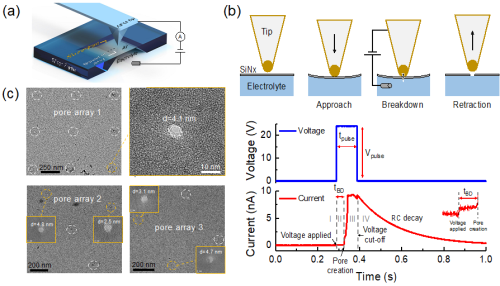While nanopores could be powerful tools for monitoring single biomolecules in solution, biological pores are limited by their fixed size and difficulty of integration in devices that can be mass produced in a semiconductor fab. In collaboration with the Grutter lab, we have developed a new technology called tip-controlled local breakdown that uses an atomic force microscopic (AFM) tip to form a nanopore in a synthetic membrane (Fig. 3). This technology, based on a standard bench-top AFM, allows multiple pore-sensors to be combined, or combined with additional detectors, electronic circuitry or tiny micro/nanochannels. Tip-controlled local breakdown, in particular, can produce very small (sub 5 nanometer) pores at precise positions, allowing for fabrication of multiple pores exactly where they are needed. We are working with Norcada, a Canadian MEMS foundary, to make the technique available to the scientific community

Fig. 1 (a) Setup based on AFM for implementing tip-controlled local breakdown (TCLB). (b) Voltage and current scan for pore production via TCLB. Note that pore-formation is confirmed via a current spike upon pore formation. (c) Example TEM micrographs of pores made via TCLB.
References:
